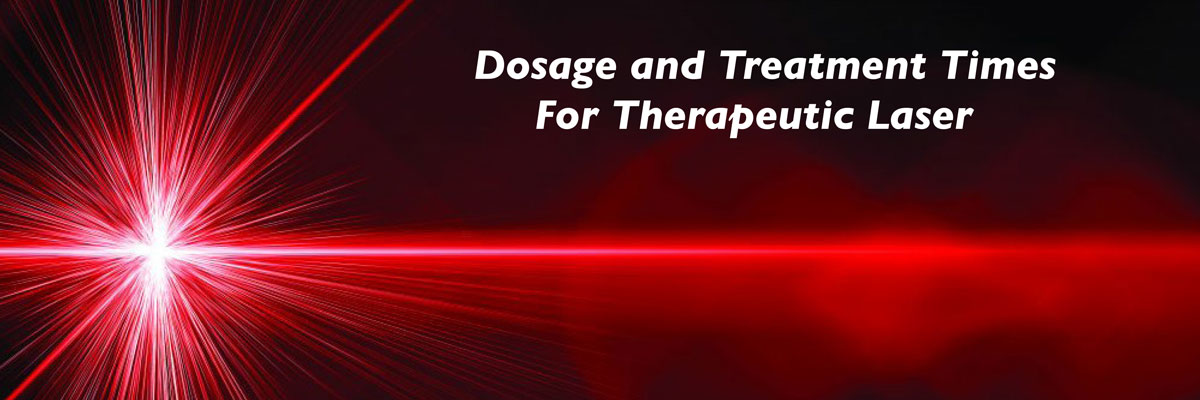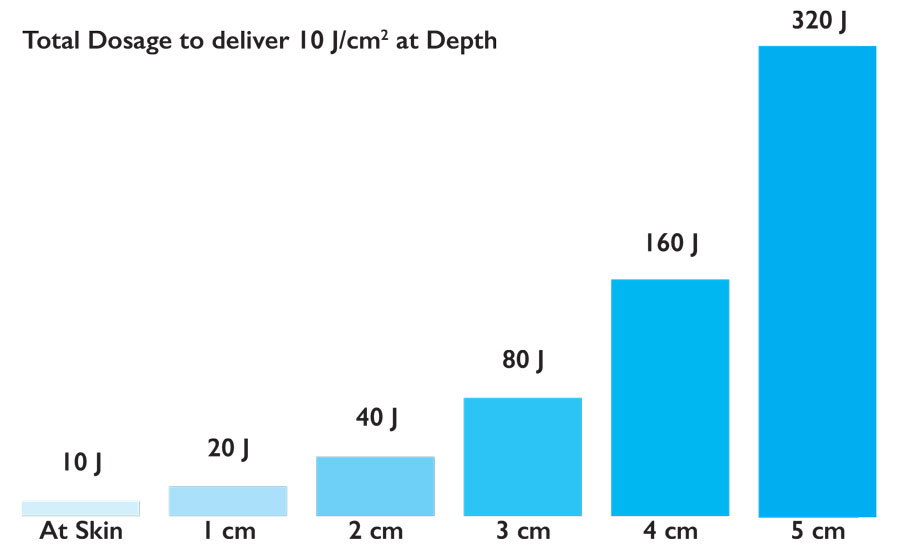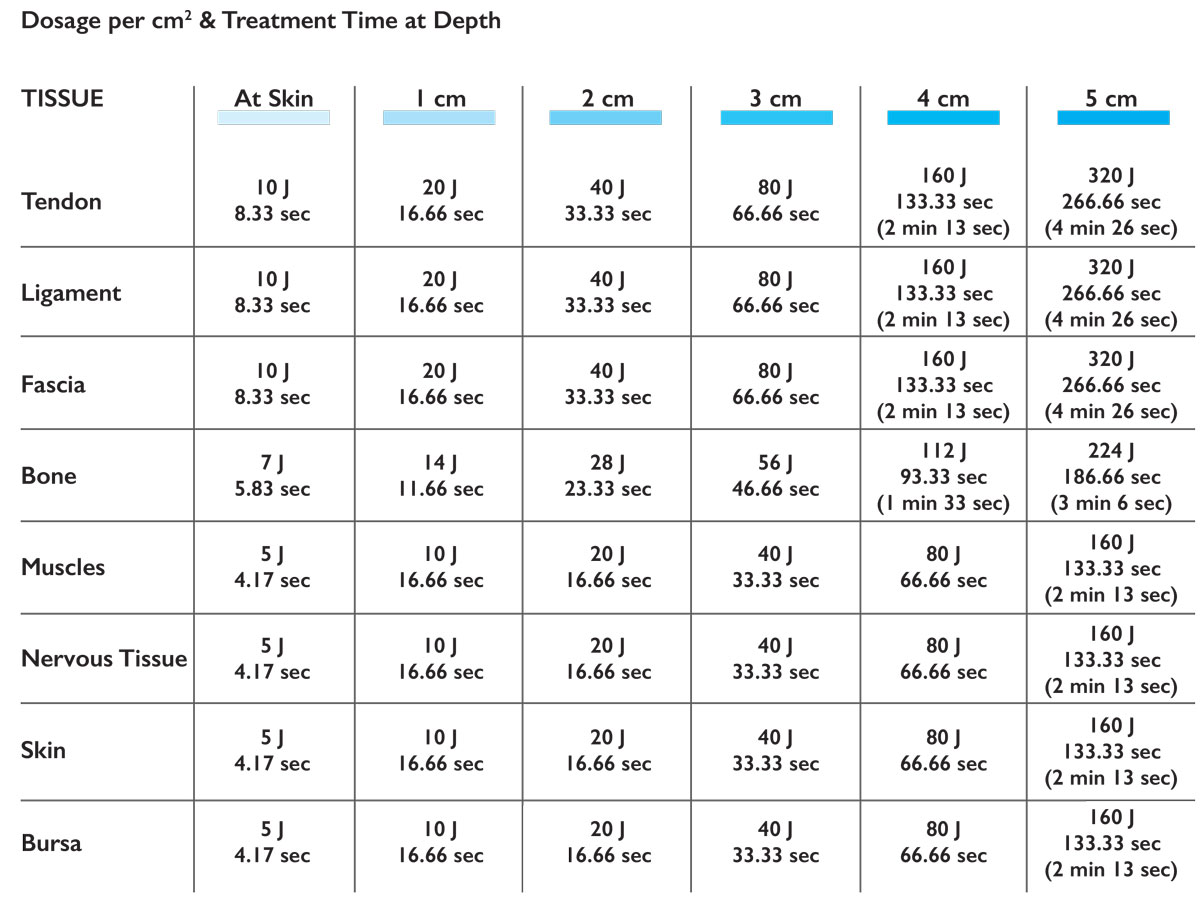Posted by Conchita Van Meurs
Dosage and Treatment Times For Therapeutic Laser Therapy

Therapeutic laser manufacturers offer a variety of suggested protocols, either on screen or through supporting documents. But as one looks at the actual dosages (Joules), they vary dramatically for the same conditions. So how can you be sure your therapy will provide outcomes?
Suggested Dosage at Target Depth
WALT, the World Association for Photobiomodulation Therapy, recommends dosages ranging from 2 J/cm2 to 10 J/cm2. Below are reasonable guidelines for common structures:
Tendon 10 J/cm2
Ligament 10 J/cm2
Fascia 10 J/cm2
Bone 7 J/cm2
Muscle 5 J/cm2
Nervous Tissue 5 J/cm2
Skin 5 J/cm2
Bursa 5 J/cm2
Modifying Dosage for Target Depth
You will note that the dosage states “at target depth.” Lasers lose about 50% of their power for each centimeter that they need to penetrate. So to deliver 10 J/cm2 at a depth of 5 cm, you will need to deliver 320 Joules per centimeter squared at the surface. See the full chart below.

As treatments for spinal disc or joints can easily reach these deeper depths requirements, modifying for depth is essential for total dosage, treatment times, and outcomes.
Calculating Treatment Time
If your laser therapy device does not display the Joules being delivered per cm squared, you can calculate your treatment times with some basic math, BUT you will need to know key parameters about your laser probe.
You will need to know:
- the Output Power (not Peak Power)
- If the unit does not offer a continuous mode, you will need the pulse duration and pulse frequency (how long per second the laser is on versus off)
- The beam area
- Is the total Output Power listed including LED and SLD diodes? These do not count towards Output Power as only true laser diode wattage is being used in the calculation.
- Are all the diodes operating in the therapeutic light spectrum of between 650 nm to 1000 nm? Any that are not, will not have their power factored into the total Output power for the equation.
Laser Output Power (in Watts) x Time (seconds) divided by Beam Area (cm2) gives you a calculation of Joules/cm2.
If you have been given Output Power per centimeter squared, you will not need the beam area, just time in seconds (if pulsed).
If you have a Superpulsed device that does not offer a continuous mode, “Time” will reduce the Joules being delivered dramatically because the probe is off for most of a second. See the example below.
You are determining how many Joules per centimeter squared your unit delivers per second to calculate an overall treatment time.
Many ANSI Class IV laser machines openly advertise these parameters, but manufacturers of Class IIIB units often will not. Class 3B covers a wide range of output powers, and the lower-powered units can have problematic outcomes, as you will see later. When purchasing a laser therapy unit, demand to know the J/cm2 per second of the probe as a condition of purchase.
If your probe head covers your entire treatment area, you will not need to factor coverage into your math. If, on the other hand, you will need to move the probe to cover the entire region you are trying to treat, you will need to expand your time appropriately by how many times you move the probe.
Treatment Time Example for Apollo 3 Watt Laser
Let’s use the Apollo 3 Watt laser probe as an example. It advertises a total energy delivery per minute of 180 Joules and 72 J/cm2. Using the equation above, Apollo would be 3 Watt x 1 second divided by 2.5 cm Beam Area. So per second, this laser probe delivers 1.2 J/cm2.
The treatment times for 10 J/cm2 at depth would therefore be:
At Skin 8.33 seconds (10 J/cm2 divided by 1.2 J/cm2)
At 1 cm 16.66 seconds
At 2 cm 33.33 seconds
At 3 cm 66.66 seconds (1 minute, 6.66 seconds)
At 4 cm 133.33 seconds (2 minutes, 13.33 seconds)
At 5 cm 266.66 seconds (4 minutes, 26.66 seconds)
As you can see, the time quickly adds up, even for a Class 4, 3 Watt (3,000 mW) laser probe running in Continuous mode (not pulsed). You can also see why the larger probe size of the Apollo is an advantage, given the more coverage for the same time.
Remember that this probe delivers a TOTAL of 3 Joules per second (180 Joules per minute) BUT only 1.2 Joules per second per cm2, so the Joules on the screen will not match, as the total probe is delivering to an area of 2.5 cm2.
For example, delivering 320 J/ cm2 will show on screen as 800 Total Joules delivered in 4 minutes and 26 seconds. (3 Joules total divided by 1.2 per cm squared = 2.5 times your intended dosage delivered to the region due to the probe being larger than 2.5 times larger than 1 cm2).
Treatment Time Example for a Superpulsed Laser
Lasers that can not operate in Continuous mode, tend to advertise a total Peak Power to make them seem very powerful. Let's put a popular example to the equation. This laser advertises a Peak power of 100,000 mW. We are estimating the Beam Area as the same as Apollo at 2.5 cm2. First we will need to figure out how long per second this laser is actually on.
This laser has a Pulse duration of 200 nanoseconds (each nano second is a billionth of a second) and a Pulse Frequency of 10 kHz (10,000 pulses per second). So 0.0000002 x 10,000 = 0.002 seconds "On" time
The actual total Output Power of this laser is 1 Watt (not the advertised 100,000 mW Peak Power)
So our equation becomes 1 x .002 seconds divided by 2.5 cm2 = 0.0008 Joules/cm2
So to deliver 10 Joules/cm2 to the skin would take 12,500 seconds or 3 hours and 28 minutes, versus the 8.33 seconds of the Continuous 3 Watt Apollo.
Estimated Treatment Times by Laser Output Power
In the book, Current Perspective in Clinical Treatment, Turner, Hode, and Karu published their estimated treatment times for laser therapy machines with various Output Powers to treat Carpal Tunnel Syndrome. Using the parameters of a dosage of 4 J/cm2 below are their estimated times by wattage:
5 mW = 35 hours
100 mW = 1 hour and 47 minutes
250 mW = 43 minutes
500 mW = 21.5 minutes
5 Watt (5,000 mW) = 2 minutes and 9 seconds
Since we do not believe many practitioners intend to apply laser therapy for hours to a single treatment site, the weaker lasers tend have problematic outcomes. In addition, in the example above all except the 5 Watt laser are likely listed as an ANSI 3B, so with treatment times varying between 21 minutes and 35 hours, it is very important to understand what you are buying.
Even if you did allow your patient hours of treatment time, there is much research suggesting that the Energy Density of these weaker units would be insufficient to create a biological response in the tissue. To learn more about Energy Density, see our BLOG.
How to Apply This
Okay, much of the above seems overwhelming, but if you know the J/cm2 per second your unit delivers, you can create a one-page cheat sheet to post near your laser to start your treatments quickly. However, keep in mind that you may also want dose-related anatomical structures to improve the outcomes, and these will require a second calculation.
The biggest questions you will need to ask your self is, "How deep are the structures I am trying to treat?"
See the example for the Apollo 3 Watt laser probe below. Again, the Joules on the screen will not reflect the Joules you intend to deliver in the chart. Instead, you will need to multiply the chart dosage by 2.5 to use the on-screen Joule counter.
Ask us for a PDF version with On Screen Joules


